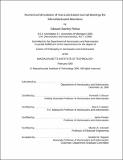| dc.contributor.advisor | Kenneth S. Breuer. | en_US |
| dc.contributor.author | Piekos, Edward S. (Edward Stanley) | en_US |
| dc.contributor.other | Massachusetts Institute of Technology. Dept. of Aeronautics and Astronautics. | en_US |
| dc.date.accessioned | 2005-05-19T14:25:19Z | |
| dc.date.available | 2005-05-19T14:25:19Z | |
| dc.date.copyright | 2000 | en_US |
| dc.date.issued | 2000 | en_US |
| dc.identifier.uri | http://hdl.handle.net/1721.1/16738 | |
| dc.description | Thesis (Ph.D.)--Massachusetts Institute of Technology, Dept. of Aeronautics and Astronautics, 2000. | en_US |
| dc.description | Includes bibliographical references (p. 203-208). | en_US |
| dc.description | This electronic version was submitted by the student author. The certified thesis is available in the Institute Archives and Special Collections. | en_US |
| dc.description.abstract | Numerical simulations of gas-lubricated journal bearings for microfabricated machines are performed with specialized tools. To maximize flexibility, an orbit method formulation is chosen for the primary tool. Its pseudospectral fluid equation solver enables run-time resolution adjustment while maintaining the efficiency advantage of spectral methods. A design framework is established for microfabricated bearings, including several new charts that reflect the unique constraints of MEMS. A duality between applied load and imbalance level is demonstrated and a method for experimentally determining appropriate loads for unknown imbalance is suggested. A large-amplitude whirling mode is shown to exist on both sides of the fixed-point threshold speed, in agreement with experimental observation. A quasi-static method for calculating shock tolerance is suggested and evaluated against unsteady simulations. Simulations of loads applied via non-circumferentially-uniform pressure at the bearing end are shown to increase the attitude angle and decrease the allowable nondimensional mass compared to the equivalent gravity-loaded case. Furthermore, the associated axial pressure gradients are shown to produce a hydrostatic stiffness via inertial effects. A nondimensional model is constructed for this stiffness and its dependence on various parameters is studied. It is shown that the load capacity advantage reported in the literature for noncircular bearings can be canceled by microfabrication constraints. The stability advantage, however, survives. Tapered axial clearance is shown to have an extremely deleterious effect on performance while bowed clearance proves less detrimental. Navier-Stokes solutions of infinite-length bearings with unity inertial parameters are performed using a second specially-built tool. Little change is found in the steady-state results from inertial and curvature effects in the MIT microengine’s parameter space. | en_US |
| dc.description.statementofresponsibility | by Edward Stanley Piekos. | en_US |
| dc.format.extent | 208 p. | en_US |
| dc.format.extent | 1789253 bytes | |
| dc.format.extent | 1789006 bytes | |
| dc.format.mimetype | application/pdf | |
| dc.format.mimetype | application/pdf | |
| dc.language.iso | eng | en_US |
| dc.publisher | Massachusetts Institute of Technology | en_US |
| dc.rights | M.I.T. theses are protected by copyright. They may be viewed from this source for any purpose, but reproduction or distribution in any format is prohibited without written permission. See provided URL for inquiries about permission. | en_US |
| dc.rights.uri | http://dspace.mit.edu/handle/1721.1/7582 | |
| dc.subject | Aeronautics and Astronautics. | en_US |
| dc.title | Numerical simulation of gas-lubricated journal bearings for microfabricated machines | en_US |
| dc.type | Thesis | en_US |
| dc.description.degree | Ph.D. | en_US |
| dc.contributor.department | Massachusetts Institute of Technology. Department of Aeronautics and Astronautics | |
| dc.identifier.oclc | 45614247 | en_US |
